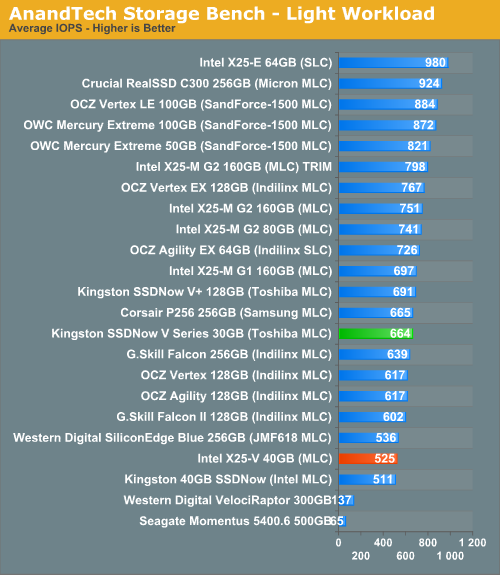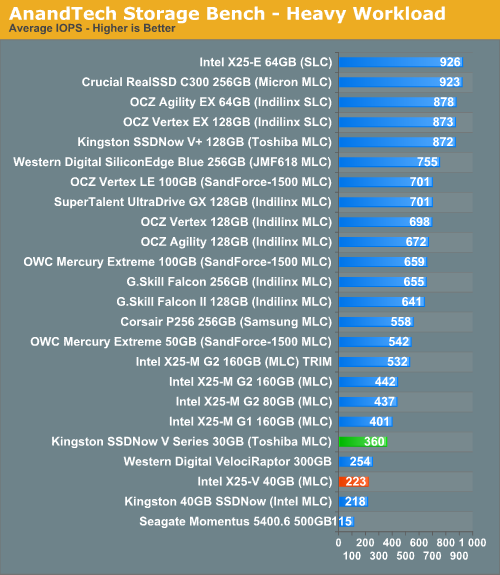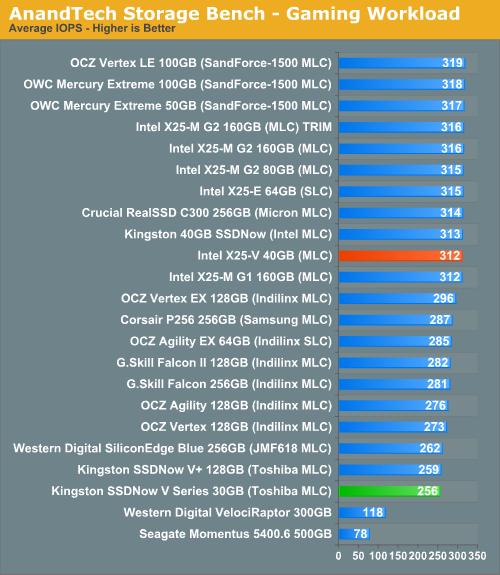Intel's X25-V & Kingston's 30GB SSDNow V Series: Battle of the $125 SSDs
by Anand Lal Shimpi on March 19, 2010 12:00 AM EST- Posted in
- Storage
AnandTech Storage Bench
Note that our 6Gbps controller driver isn't supported by our custom storage bench here, so the C300 results are only offered in 3Gbps mode.
The first in our benchmark suite is a light usage case. The Windows 7 system is loaded with Firefox, Office 2007 and Adobe Reader among other applications. With Firefox we browse web pages like Facebook, AnandTech, Digg and other sites. Outlook is also running and we use it to check emails, create and send a message with a PDF attachment. Adobe Reader is used to view some PDFs. Excel 2007 is used to create a spreadsheet, graphs and save the document. The same goes for Word 2007. We open and step through a presentation in PowerPoint 2007 received as an email attachment before saving it to the desktop. Finally we watch a bit of a Firefly episode in Windows Media Player 11.
There’s some level of multitasking going on here but it’s not unreasonable by any means. Generally the application tasks proceed linearly, with the exception of things like web browsing which may happen in between one of the other tasks.
The recording is played back on all of our drives here today. Remember that we’re isolating disk performance, all we’re doing is playing back every single disk access that happened in that ~5 minute period of usage. The light workload is composed of 37,501 reads and 20,268 writes. Over 30% of the IOs are 4KB, 11% are 16KB, 22% are 32KB and approximately 13% are 64KB in size. Less than 30% of the operations are absolutely sequential in nature. Average queue depth is 6.09 IOs.
The performance results are reported in average I/O Operations per Second (IOPS):

Intel's X25-V performs virtually identically to the older Kingston 40GB Boot Drive. The new 30GB drive does have the advantage though, performing much more like an Indilinx drive than a scaled down X25-M thanks to its higher sequential write speed.
If there’s a light usage case there’s bound to be a heavy one. In this test we have Microsoft Security Essentials running in the background with real time virus scanning enabled. We also perform a quick scan in the middle of the test. Firefox, Outlook, Excel, Word and Powerpoint are all used the same as they were in the light test. We add Photoshop CS4 to the mix, opening a bunch of 12MP images, editing them, then saving them as highly compressed JPGs for web publishing. Windows 7’s picture viewer is used to view a bunch of pictures on the hard drive. We use 7-zip to create and extract .7z archives. Downloading is also prominently featured in our heavy test; we download large files from the Internet during portions of the benchmark, as well as use uTorrent to grab a couple of torrents. Some of the applications in use are installed during the benchmark, Windows updates are also installed. Towards the end of the test we launch World of Warcraft, play for a few minutes, then delete the folder. This test also takes into account all of the disk accesses that happen while the OS is booting.
The benchmark is 22 minutes long and it consists of 128,895 read operations and 72,411 write operations. Roughly 44% of all IOs were sequential. Approximately 30% of all accesses were 4KB in size, 12% were 16KB in size, 14% were 32KB and 20% were 64KB. Average queue depth was 3.59.

Crank up the sequential writes and Kingston's lead grows. The 30GB V series drive almost performs like an X25-M G1 in this case. The X25-V on the other hand performs more like a low latency VelociRaptor. Still better than a hard drive, but don't expect to copy files any faster.
The gaming workload is made up of 75,206 read operations and only 4,592 write operations. Only 20% of the accesses are 4KB in size, nearly 40% are 64KB and 20% are 32KB. A whopping 69% of the IOs are sequential, meaning this is predominantly a sequential read benchmark. The average queue depth is 7.76 IOs.

With both Intel and Kingston equal in sequential read performance, the differentiating factor here is strictly random read performance where the X25-V has the edge.










78 Comments
View All Comments
AnnonymousCoward - Monday, March 22, 2010 - link
410GB for apps, are you insane? The only way I can see that possible is if you store every warez app out there.Even my bloated work machine only uses 21.3GB.
davepermen - Saturday, March 20, 2010 - link
tell that to our work systems which have all sort of apps on + os (+office, sap, and many other things) and all have only a c:\ drive.it's perfectly doable. not for everyone (esp. not for gamers), but for more than people might imagine.
iwodo - Friday, March 19, 2010 - link
While the idea of $125 for 80GB Intel SSD is nice, but if we dont get any performance improvement over current Gen then market might wait again.SATA 3?
ONFi 2.0 / 2.2?
Faster Random Read / Write?
I really hope we get new Intel SSD controller.
Japunie - Friday, March 19, 2010 - link
I'd like to see some benchmarks showing time saved. That's my main issue with a benchmark. Most show a higher number, but don't exactly show yo uhow much time your saving.Gaming benchmarks are self-explanatory but I would love to see more benchmarks showing the time difference as that to me is the ultimate reason to upgrade not just to have the fastest card, what have you.
semo - Sunday, March 21, 2010 - link
i'm for more real world testing. fot consumer sata drives stuff like startup times and virus scans. for eneterprise sas drives i want to see exchange, sql, etc performance numbers.AnnonymousCoward - Saturday, March 20, 2010 - link
You're absolutely correct. I've posted this 3 times and emailed Anand directly, but he continues to ignore it.http://tinyurl.com/yjcr5vm">http://tinyurl.com/yjcr5vm
http://tinyurl.com/ylflfao">http://tinyurl.com/ylflfao
There's no question that he's dead wrong to not address the single thing that matters with hard drives: time. Without it you can't see how significant the difference between drives are, the AnandTech Storage Bench doesn't mean squat since drives like the SandForce use compression, and hard drives have a long history of performing differently in benchmarks vs real life. For proof of those last two points, check out http://tinyurl.com/yamfwmg">http://tinyurl.com/yamfwmg where RAID0 bought 20-40% more IOPS but zero load time.
The only SSD time benchmarks I know of here are Pages 29 and 30 of the very first review http://tinyurl.com/yd73sf8">http://tinyurl.com/yd73sf8. Whuddayaknow, the Vertex boots up 1.2s slower than the X25-M, and loads WoW realms 1.4s slower. How about that, something tangible and meaningful to compare.
Belard - Friday, March 19, 2010 - link
Don't they usually?The kinds of numbers that are easy to understand:
- Win7 boot time (after POST is preferred, but whatever)
- Loading of a game, loading of a game while doing a background task.
- virus scan
- Loading and saving a large file in Photoshop or Excel.
- Win7 Shutdown time.
- Win7 Wake up (perhaps to quick).
My own experience with Win7 and the intel X25-M-G2
Win7 boot:
1m25s = Temp 160GB HD SATA (not a fast drive)
0m09s = Intel SSD (same computer)
0m35s = Another PC with a typical 500GB 7200RPM drive.
Belard - Friday, March 19, 2010 - link
All the Sandforce drives are near the top, in general.But I'm not really seeing those drives out in the market? What are those prices like.
I have my experience with intels X25 G2 drives and they still seems to offer the best overall deal. Reliability, TRIM and price (now). The 80GB G2 is down to around $200... so spend an extra $80 and double the space to work with and vastly improve the performance over any of those drives.
A typical Win7 setup with NO user data is about 15GB, which mine is with various Adobe programs, 3 browsers, Office suite and dozens of add-ons. So a 30GB is barely enough for future usage. 40GB is fine, but the performance needs to be better IMHO in order for it to be an excellent desktop boot drive. In one of our desktops in an office, Win7 boots up about 8~10 seconds after POST. Everything is instant.
Scalptrash - Friday, March 19, 2010 - link
Less expensive, better specs. Hmmm...Ijiwaru - Friday, March 19, 2010 - link
newegg lists the 30GB at 89.99 standalone and 114.99(84.99 after MIR) for the kit.buy has the kit at 78.95 after MIR
amazon has the kit at 111.11